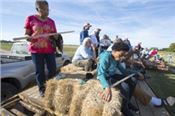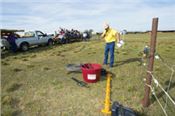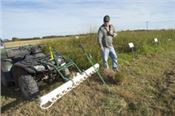|
Pasture Care Highlights AgCenter Cattle Field Day
ALEXANDRIA, LA.
Taking good care of pastures can help cattle producers keep animals healthy and adequately nourished, LSU AgCenter experts said during a field day at the AgCenter Dean Lee Research and Extension Center near Alexandria.
Sending forage samples to a lab for nutrient analysis is one way to see if cattle are getting enough protein and other nutrients, said AgCenter agent Rodney Johnson.
“That way we can adjust so our cattle are at the right condition score,” he said, referring to a scoring system where 1 is emaciated and 9 is obese. An ideal score is 5 to 6.
Forages should contain a minimum of 9 percent protein, he said. That percentage must increase sometimes, such as when cows are pregnant or lactating, for cattle to maintain a healthy weight.
Pastures may be able to accommodate additional grazings if treated with environmentally smart nitrogen, a fertilizer product with a temperature- and moisture-sensitive coating, said AgCenter research associate Jeff Gurie. He told about the results of a multi-year project in which three ryegrass plots were treated with urea, urea plus the Agrotain nitrogen stablizer and environmentally smart nitrogen (ESN), respectively.
In 2015, the ESN-treated ryegrass plots reached grazing height fastest, allowing them to be grazed six times as compared to five in the others. In 2016, each fertilized plot was grazed only four times, a reduction Gurie said was possibly caused by weather conditions.
The ESN coating helps prevent the rapid volatilization seen with urea, which causes plants to have insufficient nitrogen when they begin to emerge, he said.
Producers should watch for troublesome grass weeds that shade pasture grasses and inhibit growth.
“Selecting a grass out of your desirable grass – that’s the hardest thing to control,” said AgCenter weed scientist Ron Strahan.
He reviewed products available to control johnsongrass in bermudagrass pastures, including Pastora, Outride and glyphosate. He said glyphosate applied with a wick bar attachment on a four-wheeler provided the best control in his tests.
Strahan also said smutgrass, a prolific seed-producing perennial often found on overgrazed and compacted pastures, is moving northward in Louisiana. He said the Velpar herbicide, which needs rainfall to be activated, is a good control option.
Dwayne Rice, a grazing land specialist with the Natural Resources Conservation Service, demonstrated how to use grazing sticks. The sticks, which are yardstick-like tools printed with conversion charts and other information, can be used to estimate how much forage a pasture will yield.
Chris Thomson, a Pineville veterinarian, warned that wet weather this year has increased the risk of cattle contracting blackleg disease, which can be fatal. He encouraged people to keep vaccinations up to date for both calves and adult cattle.
“Most of the diseases out there are easily preventable with vaccination,” Thomson said.
Field day attendees also heard tips on building fences. Glen Gentry, resident coordinator of the AgCenter Bob R. Jones-Idlewild Research Station near Clinton, talked about different types of fences and materials.
Gates should be installed in well-drained areas, and corner braces should be set at least 3 feet deep, said AgCenter agent Vince Deshotel.
“That’s the framework and structure for the stability of the fence over time,” Deshotel said.
The research showcased at the field day represents a strong commitment to improving the beef cattle industry in Louisiana, said Phil Elzer, AgCenter associate vice president.
Economics forced the closure of the AgCenter forage testing lab at the Southeast Research Station in 2015, and faculty departures led to herd downsizing at the Hill Farm Research Station earlier this year. But cattle research continues on the LSU campus – where Elzer said three new faculty members who are focusing on cattle were recently hired – and at other research stations around the state, including Dean Lee.
“We value our research stations,” Elzer said. “They are critical to serve you.”
Randy Toups, president of the Louisiana Cattlemen’s Association, praised AgCenter researchers’ work.
“LSU has a very, very good program,” Toups said. “If you take just one of these practices home with you, you’re going to improve your operation.” ∆

Attendees of a cattle and forage field day study their grazing sticks while listening to a
presentation on how to use the tools to estimate how many pounds of forage a pasture
will yield. The field day was held at the Dean Lee Research and Extension Center near Alexandria.

Glen Gentry, LSU AgCenter animal scientist and resident coordinator of the Bob
R. Jones-Idlewild Research Station near Clinton, right, describes fencing materials
that can be used in cattle operations during a field day at the Dean Lee Research
and Extension Center near Alexandria.

LSU AgCenter weed scientist Ron Strahan tells about how he used a four-wheeler equipped
with a wick bar to apply glyphosate to control johnsongrass in the plots behind him. Strahan
was speaking at a cattle and forage field day at the Dean Lee Research and
Extension Center near Alexandria.
|
|